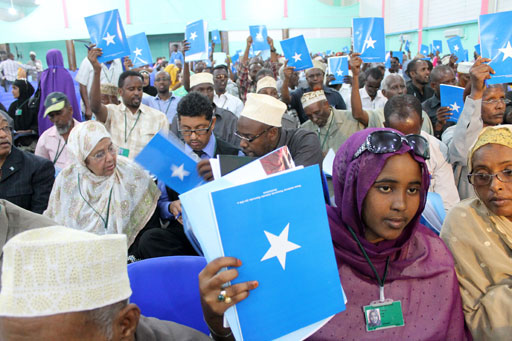By Marco Zoppi
The constitution approved in 2012 represents an opportunity for Somalia to re-establish a central government which has been absent for the last two decades, and reach a stability that its society lacks since the pre-colonial era. The constitution envisages the implementation of a federalist structure for the new Somali state, a solution that is facing a number of issues in the prickly Somali political environment. However, these issues do not seem to be insurmountable; the question is if the Somali Federal Government (SFG) and the other actors involved are approaching the question with proper legal means and good intentions. Now as before, the core of the matter lies both in the relationship among Somali clans as well as in the harmonization of the different sources of authority which can be found on the ground. The analysis of federalism in Somalia, as it has been formulated so far, can thus shed light on the progress made towards stability and consequently on the practical possibilities to overcome a political impasse that has lasted over twenty years.
FEDERALISM IN THE 2012 CONSTITUTION
 The configuration of the Somali State as a federalist one has been decided by the National Constituent Assembly, which adopted the Draft Constitution on August 1, 2012.
The configuration of the Somali State as a federalist one has been decided by the National Constituent Assembly, which adopted the Draft Constitution on August 1, 2012.
Article One states unequivocally that “Somalia is a federal, sovereign, and democratic republic founded on inclusive representation of the people and a multiparty system and social justice”.
Leafing through the document, one reads that “the Federal Republic of Somalia is founded upon the fundamental principles of power sharing in a federal system” (Art.3) and that shari’a maintains its supremacy on the constitution (Art.4). The subsequent articles of the constitution dedicated to federalism can be found in “Chapter 5: Devolution of the powers of government in the Federal Republic of Somalia” (Articles 48 to 54). In this section, the constitution describes the collaborative spirit that shall be established between the federal government and the federal state government level, and goes on by listing practical issues that need to be approached with a cooperative relationship. Neither the Constitution nor other documents, however, do provide a comprehensive description of all aspects of the federal system: if, on the one hand, the constitution seems to include much of the federal political system’s principles, on the other it does not directly deal with some other relevant issues, whose specifications are instead entrusted to the decisions which will be taken by three institutional bodies:
1) Federal State Parliaments
2) The House of the people (the lower house of the Federal Parliament)
3) A National Commission appointed by the House of the people
These bodies have the task of solving questions as urgent and relevant as the definition of the federal boundaries. Nevertheless, two of the three are not really operative at the moment.
Following constitution’s regulation, the House of the people has the specific task of defining the territorial extension of federal states, yet before doing that it needs preliminary analyses on the issue which will be conducted by the National Commission. Afterwards, the single federal state parliament can proceed with further division of its own territory into districts. As seen, the National Commission is appointed by the House of the people: article 49 entrusts in fact the Lower House with the duty of defining:
1) responsibilities and powers of the National Commission;
2) parameters and conditions that shall be used for the establishment of the federal Member States;
3) the number of the commissioners, requirements for the appointment and terms of office.
We can extract two principles here. Firstly, the House of the people has a substantial power over the National Commission it shall establish. The National Commission in fact will carry out a preliminary research that anyway depends on specific parameters and conditions expressed by the Lower house, with no real spaces for autonomous moves. It is important that the Lower House enjoys popular legitimacy all the way through in order for the National Commission, and for the boundaries which commissioners will trace, to obtain legitimacy too.
Secondly, a well-defined hierarchical structure does emerge in this section of the constitution, yet it leaves itself vulnerable to a multilevel political power bargaining, as every level maintains, proportionally, a margin of negotiation and influence on the final boundary organization: a potential minefield of political conflict, overlapping interests and procrastination.
Marco Zoppi
Email: [email protected]
We welcome the submission of all articles for possible publication on WardheerNews.com. WardheerNews will only consider articles sent exclusively. Please email your article today . Opinions expressed in this article are those of the author and do not necessarily reflect the views of WardheerNews.
WardheerNew’s tolerance platform is engaging with diversity of opinion, political ideology and self-expression. Tolerance is a necessary ingredient for creativity and civility.Tolerance fuels tenacity and audacity.
WardheerNews waxay tixgelin gaara siinaysaa maqaaladaha sida gaarka ah loogu soo diro ee aan lagu daabicin goobo kale. Maqaalkani wuxuu ka turjumayaa aragtida Qoraaga loomana fasiran karo tan WardheerNews.
Copyright © 2024 WardheerNews, All rights reserved


